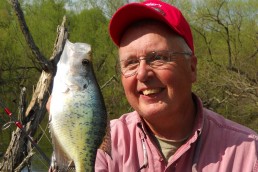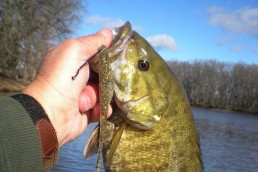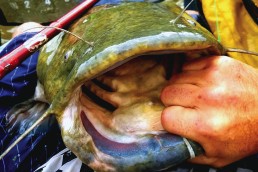Springtime Speck-tacular Methods
SHARE THIS POST
Springtime is speck time. And now is when anglers have a story to tell about catching huge numbers of slab-sized crappies (specks) in April, May or early June. However, when prodded, they also can tell you about numerous trips when the pickings were slim.
So why is there a discrepancy?
A big piece to the question about consistent catches is location, location, location.
Both black and white crappies spawn when water temperatures are between 62 and 65 degrees. Before this, they stage in deep-water areas relatively close to their spawning grounds. If an angler wants some pre-spawn action, look for drop-offs with wood near potential spawning areas. The best time to start fishing for pre-spawners is when the water is at least 50 degrees. Below this, fish are lethargic, and much harder to catch. As the water hits 50 degrees, fish become more aggressive.
These pre-spawn areas can be in depths of 10 to 25 feet and found near stumps and submerged timber. An ideal piece of structure for spawn then would be a hard bottom point that has wood and drops-off into a creek channel.
Do a controlled drift over the structure and watch the locator very carefully. When the screen shows wood with fish, use the trolling motor to hover over the stump. A good crappie rig for drifting has a 1-ounce pencil lead tied to the end to the line. Use a crappie rig or tie three size 4 or 6 snelled wire hooks, 12 to 18 inches apart. The first hook—closest to the sinker—will hang about 12 inches above the lead.
Lower the sinker until it barely touches wood then slowly lift it up and down, just above the tops of the log or stumps. When resistance is felt, lift the rod tip and set the hook. Immediately throw out a marker buoy after catching a crappie. A quality graphite rod with a reel spooled with FireLine aids in detecting any light taps from non-aggressive specks.
By having three hooks spaced out, the angler is then able to cover a greater range of depths. Deep-water crappies tend to suspend, and this 4-foot spread of baits increases the chances of locating and catching them. When drifting, use the trolling motor to keep the bait fairly perpendicular to the boat.
When these crappies move into the spawning grounds, this is when those aforementioned stories are made. However, there are tricks and tactics for consistently catching them.
Are you enjoying this post?
You can be among the first to get the latest info on where to go, what to use and how to use it!
First, find fish-holding spots. Prime locations contain stumps, trees, vegetation, overhanging banks, rocks, etc. The classic spot is the shallow end of a creek channel or a bay with brushy banks and laydowns. Hard-bottomed gravel areas are preferred, but sand or softer bottoms are used by the white crappies. Scattered green vegetation is also good. Other spots for the spawn include boat marinas, areas near a stream mouth, shallow points, channels in nearshore areas and hard bottom flats. The bigger crappies tend to spawn in 3 to 5 feet while the smaller fish do so in shallower water.
In these shallower areas, crappies are very light sensitive. That’s why the best catches occur on gray overcast days and during the early-morning and evening hours. Some of the best action can occur after dark too. This is when anglers can cast bobber-held minnows and wait for crappies to come to them—that is, if they’re fishing near spawning sites. Causeways are also some of the best locations for action for the shore and boat anglers.
Use a chartreuse, 1/32-ounce jig tipped with a small twister tail or some other 1- or 1 1/2-inch soft plastic bait. I have a favorite plastic bait that is a consistent producer for me: the Panfish Assassin’s Electric Chicken Tiny Shad. Fish it under a small float and cast it over a good-looking piece of crappie habitat. Slowly retrieve the float while constantly jiggling the rod tip. A light-action rod is also preferred. Periodically stop the retrieve for a few seconds before continuing the retrieve. High, bright sun and cold fronts tend to drive the crappies from the shallows. When this occurs, the fish are tough to catch as they are sulking in the deeper waters adjacent to the spawning sites.
While crappies make a nest, it’s not as visible as a saucer-shaped bed of the bluegill. Often, it is just a bare spot among the weeds or submerged timber. And having a pair of Polaroid sunglasses or other polarized eyewear greatly increases an angler’s chance of seeing fish.
A super-quiet approach is necessary when fishing shallow-water spawners. If they’re spooked, mark the area and come back later. And stay as far from the fish as possible. Personally, a 20-foot telescoping pole is my favorite spawning-crappie weapon followed by a 10 1/2-foot noodle spinning rod. These long poles let me drop the bait quietly and delicately from a longer range. Whether using telescoping poles or cane poles, do not tie the line to the pole’s eye. These are not designed for pressure; pass the line through the eye and tie it around the pole’s shaft a foot from the tip. Use electrical tape to hold the knot from sliding and 20-pound-test braided line with a 12-inch fluorocarbon leader.
The longer poles allow the hook to be vertically dropped among limbs and roots. Use a single-wire hook or a small jig with a wire hook. This can then be bent out when snagged. I often don’t use a float; the bait must be positioned right in front of the crappie’s nose. Nesting crappies tend to not grab a hook when it’s on the bottom. Position it too high above the spawners, and they often won’t chase it. Have the bait at nose-height or a few inches above it. When using a float, leave the beach ball-sized bobbers at home. These specks are spooky and a large float with heavy split shot crashing down on their heads drives them away. When using floats, use the small ice bobbers, if possible.
Lively dorsal-hooked minnows, ice spoons tipped with maggots, and 1/16- and 1/32-ounce jigs baited with small twister tails or tubes, can catch plenty of spawners when correctly presented. If a bait isn’t producing, switch to another offering or change the color of the tube or twister tail. Set the hook the moment the fish mouths your bait. Longer poles will let you quickly pull the fish straight up through the morass of twisted limbs and roots. Give a slab crappie its head, and it quickly knits your line into a snag. And if the fish you’re catching are running small, work the cover that’s in 4 to 6 feet, as larger fish may be taken from these deeper areas.
When you’re looking for a bucket of slab crappies this spring, try some of these tricks of the trade. When done properly, speck-tacular catches can occur.
MWO
SHARE THIS POST
Did you enjoy this post?
You can be among the first to get the latest info on where to go, what to use and how to use it!
Paul Liikala
Paul Liikala was raised on a farm which was close to Lake Erie and the Grand River. He was fortunate to have parents who nurtured his love for the outdoors. His only hope is that his writings show the love and admiration that he has for the Great Outdoors and its participants.



